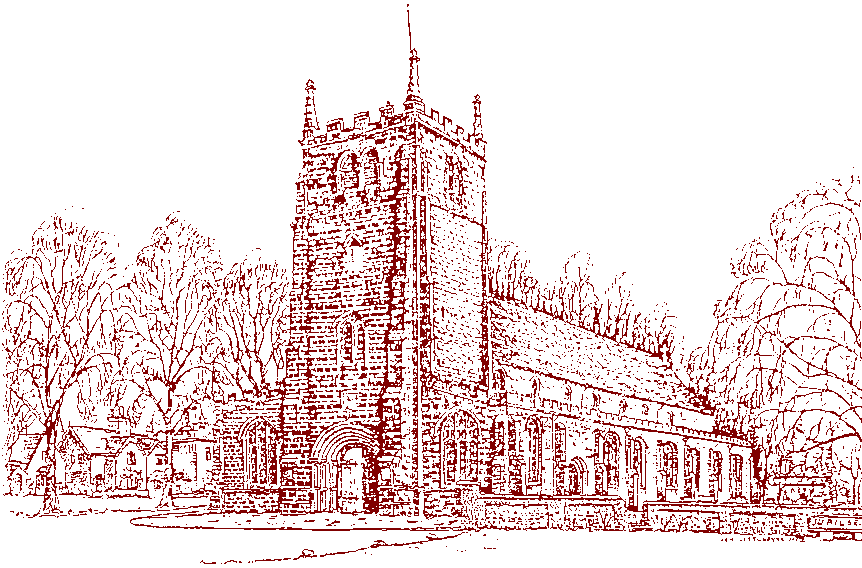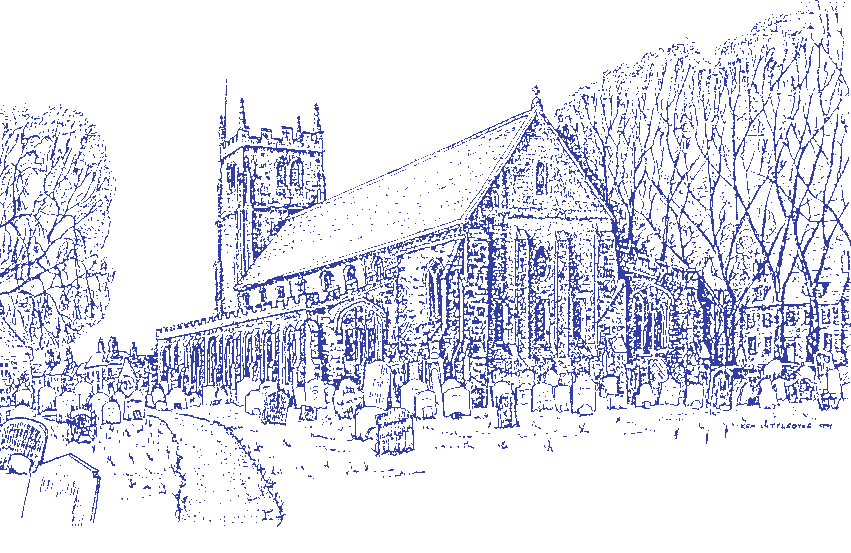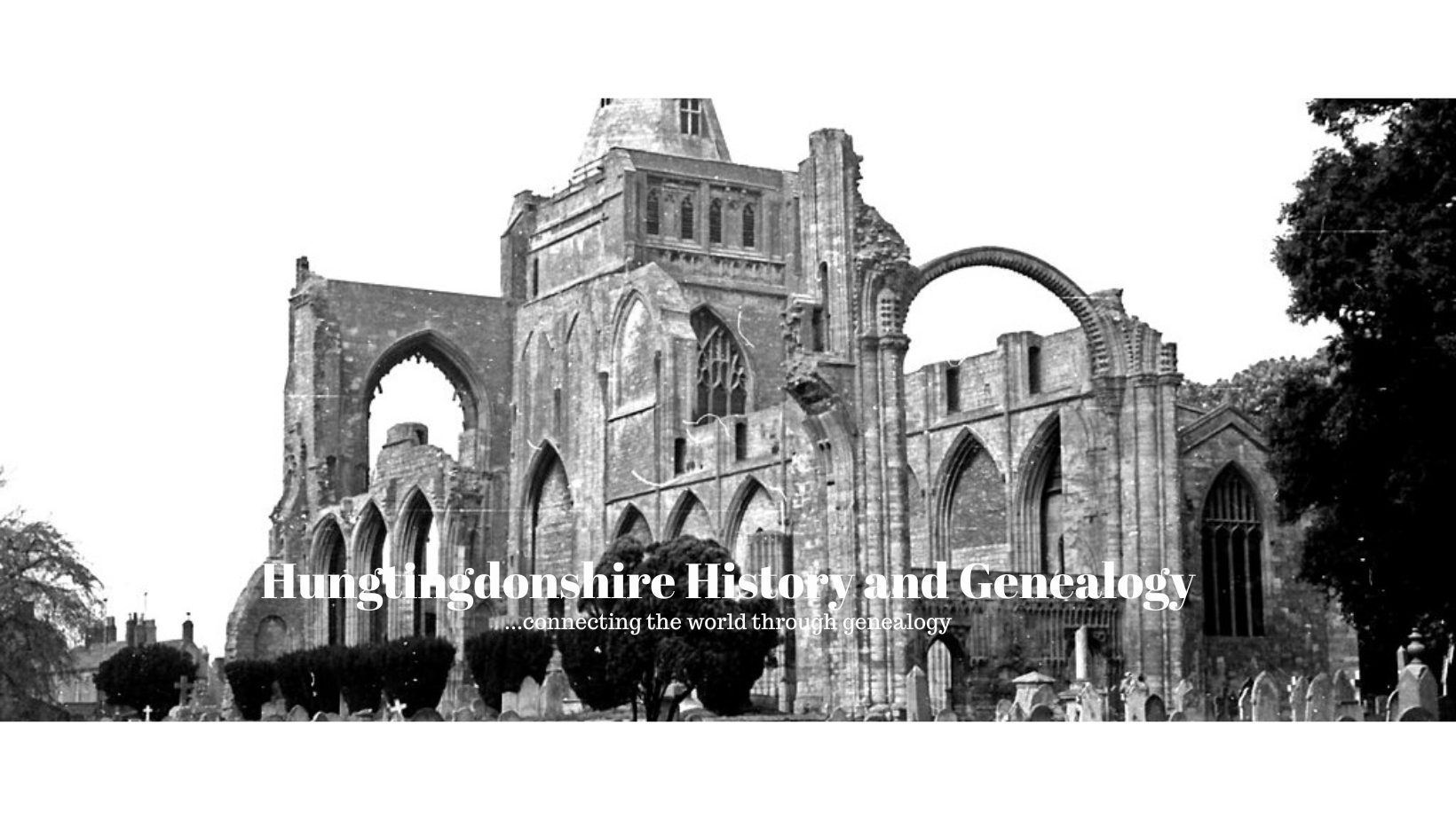Submitted by an anonymous source - thank you who ever you are
A BRIEF HISTORY AND DESCRIPTION
Cole's Manuscript of 1774 describes the church as a "good handsome building, consisting of a square tower, a nave which is very long  and chancel as short". It has an unusual origin: it was not built as a church at all, but as a 'hospitium', that is a guest house for pilgrims, or perhaps a hospital, which was founded about 1180 and seems to have been dissolved before 1291. During this period the lay people of the parish had a right to worship in the Abbey Church.
and chancel as short". It has an unusual origin: it was not built as a church at all, but as a 'hospitium', that is a guest house for pilgrims, or perhaps a hospital, which was founded about 1180 and seems to have been dissolved before 1291. During this period the lay people of the parish had a right to worship in the Abbey Church.
It was possibly consecrated as a parish church (with many others in the Diocese of Lincoln in which it was then situated) in the year 1237, under pressure from papal authority: the first reference to a parish church is in 1291. It may have been dedicated to St. Mary Magdelene, on whose day the town's feast day occurs, but according to Cole it was dedicated to St. Mary and St. Benedict: it was later renamed after the popular hero and Saint, Thomas a Becket.
THE CHANCEL
This was built in pure Norman style about 1180. Its vault is distinguished by broad, heavy unmoulded cross-ribs. The east wall has three round-headed lancets, and an unusual fish-shaped (or ash) window above. On the south side is a double piscina under a canopy and the remains of a plain sedilia in three compartments. There were south and north two-bay chapels which opened into the chancel. By the south door are the remains of a chapel, evidently in ruins before Prebendary Robins died in 1673, since he requested the word 'Resurgan' to be cut on a stone close to his grave, and that stone is on the outside of the south wall of the chancel. Close to the east buttress is part of a column, and its capital (one of three) is built into this wall. On the north side was another, and larger chapel, as seen by the diagonal groove in the east wall showing the line of the roof. In the north wall of the chancel (in what is now a vestry) are parts of two pillars of the same type as on the south side; there is also a broken piscina, a shelf and an aumbry (a recess to hold the sacred vessels for Mass and Communion). The east wall of the chancel, seen from outside, is a splendid piece of Norman work with pilaster buttresses. The dressed stonework extends to a little above the top of the ellipse window. The rest is rubble work carried up when a long high-pitched roof took the place of the old flat roof. In this rubble work there is a round-headed window blocked up; evidently there was a priest's chamber over the sanctuary, approached in very much the same way as the rood loft was entered, from outside.
Returning to the inside, the fine, substantial pointed chancel arch is supported by a pair of magnificent clustered half-piers (or responds), one half with a scalloped capital at the same height as the piers of the nave. The inner half is carried much higher to provide the necessary elevation for the chancel arch. The chancel possesses some good stained glass by 'Morris & Co', but after the deaths of Morris and Burne-Jones. The window. on this south wall, was reopened by Lord de Ramsey in 1909; it was probably closed in pre-Reformation times when the south chancery chapel was built.
The lectern, according to Black, is probably the oldest double lectern in the country, about 1450. It had, until earlier this century, the original chain and the great Bible (the cover of which had the Tudor Rose stamped on both clasps and basses) with a brass- bound and chained copy (acc. to Kelly's Directory) of Dean Comber on the Book of Common Prayer and a black-letter copy Erasmus. Paraphrase of the New Testament. At the top of each buttress is the figure of an Evangelist: the originals were stolen in 1934, and copies made in 1972. The rotating top is mostly 19th century.
The organ was built in 1903 at a cost of £250.
The Carved oak pulpit was given in 1900 by the second Baron de Ramsey, and the carved oak altar was erected in memory of the Revd. Henry Mawdesley (53 years a curate and minister of the parish), who died in 1840, and of his son Revd. Henry Worsely Mawdesley, 13 years incumbent of Upwood, who died in 1864.
The large ornate standing monument to W.H. Fellowes (died 1837) is in the Gothic style with two small allegorical figures by Hopper.
There is a list of incumbents from 1237 on the north wall.
THE NAVE
Work on the nave proceeded from east to west. The arches are flat-pointed, indicating a beginning of the trasition from Norman to Early English. This is 12th-centurv work, probably 1180 to 1190. Black (who dates it earlier) describes the nave as "singularly elegant and light, simple and refined". There are seven bays (formerly eight) of large spacious arcading with each pier and capital different, including some rich and elaborate carving: they should be looked at one by one. Moving from east to west, the pairs are: quatrefoil, quatrefoil with subsidiary shafts, round, quatrefoil with subsidiary keeled shafts, octagonal, and finally clusters of eight keeled shafts. The capitals include scallops, various water-leafs, and cocottes. In the vestries on either side of the tower are buried arches, and on one capital (in what is now a kitchen) are traces of fresco colouring.
The clerestory shows how the walls were heightened when the aisles were raised, and new windows inserted throughout in the Perpendicular style. Over the second pier from the chancel arch are two openings, where the rood loft formerly stood, approached apparently from the outside. The rood screen was pulled down in 1844. There are traces of fresco work on the north side, suggesting dimly a man or an angel or, according to one source, a man in a red cloak holding his head in his hand.
The wooden roof was constructed in the mid-19th century. Above it is a fine Oak medieval roof, which hopefully one day can be revealed in its former glory. The font is of Purbeck, or Northampton, marble, hexagonal in shape. Black conjectures that it is extremely early, possibly earlier than any portion of the existing church: Pevsner on the other hand, dates it as 13th century. The centre column is modern, the original having been lost when the font was disused and buried beneath the floor. It was restored in 1843-44 when an extensive restoration of the church took place, including perhaps the building of the roof and the addition of the 'poppy-head' pews.
The Lady Chapel in the south aisle was created in 1950 as a thanksgiving for the safe return of Lord de Ramsey from a Japanese prisoner-of-war camp. The altar table is Jacobean. The small altar in the north aisle is from St.Benets Chapel in Ramsey Hollow, now closed.
Further extensive alterations were made in 1903, when the western gallery was removed, choir stalls erected, and the organ was placed at the east end of the nave. The two western vestries were pulled down in 1910, seating for an extra 100 people was provided, and a new vestry was built (in memory of King Edward VII) on the site of the north chantry chapel by Lord de Ramsey. The present clergy and choir stalls were made in Stamford in 1960' and added-to in 1977.
THE AISLES.
An elegant tablet on the wall of the south aisle was erected by the parishioners of Ramsey as a memorial of their gratitude to Edward Fellowes for re-seating and otherwise restoring this church. This incorporate a cartouche with garlands after the style of Gibbons. When the walls of the aisles were raised, the old round-headed windows gave place to larger ones. Pevsner describes them all as Late Perpendicular, but Black says of the four western windows on the north side that they are "good decorated work, but evidently fashions were changing, and all the others are early Perpendicular".
A neat tablet on the wall of the north aisle bears the inscription "in a vault at the east end of this churchyard are deposited the mortal remains of James Smith, surgeon, who was fifty years an eminent practitioner in this town. He departed this life March 9th. 1848, in the 76th year of his age". Cole describes a number of monuments which have now gone, as well as old stained glass. Sir Oliver Cromwell and several of his family were buried here, but there are no inscriptions. The indents of several brasses remains on large slabs, possibly of abbots or priests of Ramsey.
Cole also; describes a south porch with a tiled roof. It was pulled down in the mid-19th century.
The kneelers were made by members of the parish in 1968-71; more were added in 1985.
THE TOWER.
Standing at the south-west angle of the church, it will be seen that the west-wall has been cut through vertically on each side of the tower, and the aisle walls heightened with rubble work. Originally there was no tower, only a belfry. The last Abbot of Ramsey, John Lawrence, by his will dated 29th February 1537, ordered his executors to pay "towards the building of a Stepule in the Parish Church of Ramsey when the town will build it £13.6.8." but the town never seems to have done anything except build a 'low wooden steeple' or belfry. When this belfry fell, the Churchwardens in 1672 'took stone from the Abbey' and built the present tower. Black suggests one of the ruined towers of the abbey church was taken down and rebuilt in the new position and patched as required. Apparently the original entrance arch and columns of the churchyard, were carried back and rebuilt into the east side of the tower, to become the door into the body of the church. The outer door has no affinity with the interior work; it is a fine, deeply recessed round-headed arch. In one capital there are coiled bodies of serpents meeting at the angle in one serpent's head.
The bell-openings and other places show clearly the re-use of older materials. The clock-face almost obliterates a very early 13th century window. Those on the stage above are later, and there are some curious bosses inserted at the corners beneath the battlement.
The tower contains a medieval sanctus bell and a "mellow and pleasing peal of six bells" Cast in 1810. The lintel of the door by which the belfry is entered is made of a portion of a coped coffin lid, which had once covered the resting place of an Abbot or Prior. Another is in the wall of the south-west corner of the church, and another now covers the grave of Mr. G. Jones, at the east end of the church, and still yet another, of more elaborate workmanship, has been carried to Broughton. There was in the old vicarage garden (now the Ramsey Club House) the capital of a large column with the same interlaced work as in the western door of the tower.
The churchwarden's names and dates, are cut on the oak beams of the bell-frame.
THE CHANCEL
This was built in pure Norman style about 1180. Its vault is distinguished by broad, heavy unmoulded cross-ribs. The east wall has three round-headed lancets, and an unusual fish-shaped (or ash) window above. On the south side is a double piscina under a canopy and the remains of a plain sedilia in three compartments. There were south and north two-bay chapels which opened into the chancel. By the south door are the remains of a chapel, evidently in ruins before Prebendary Robins died in 1673, since he requested the word 'Resurgan' to be cut on a stone close to his grave, and that stone is on the outside of the south wall of the chancel. Close to the east buttress is part of a column, and its capital (one of three) is built into this wall. On the north side was another, and larger chapel, as seen by the diagonal groove in the east wall showing the line of the roof. In the north wall of the chancel (in what is now a vestry) are parts of two pillars of the same type as on the south side; there is also a broken piscina, a shelf and an aumbry (a recess to hold the sacred vessels for Mass and Communion). The east wall of the chancel, seen from outside, is a splendid piece of Norman work with pilaster buttresses. The dressed stonework extends to a little above the top of the ellipse window. The rest is rubble work carried up when a long high-pitched roof took the place of the old flat roof. In this rubble work there is a round-headed window blocked up; evidently there was a priest's chamber over the sanctuary, approached in very much the same way as the rood loft was entered, from outside.
Returning to the inside, the fine, substantial pointed chancel arch is supported by a pair of magnificent clustered half-piers (or responds), one half with a scalloped capital at the same height as the piers of the nave. The inner half is carried much higher to provide the necessary elevation for the chancel arch. The chancel possesses some good stained glass by 'Morris & Co', but after the deaths of Morris and Burne-Jones. The window. on this south wall, was reopened by Lord de Ramsey in 1909; it was probably closed in pre-Reformation times when the south chancery chapel was built.
The lectern, according to Black, is probably the oldest double lectern in the country, about 1450. It had, until earlier this century, the original chain and the great Bible (the cover of which had the Tudor Rose stamped on both clasps and basses) with a brass- bound and chained copy (acc. to Kelly's Directory) of Dean Comber on the Book of Common Prayer and a black-letter copy Erasmus. Paraphrase of the New Testament. At the top of each buttress is the figure of an Evangelist: the originals were stolen in 1934, and copies made in 1972. The rotating top is mostly 19th century.
The organ was built in 1903 at a cost of £250.
The Carved oak pulpit was given in 1900 by the second Baron de Ramsey, and the carved oak altar was erected in memory of the Revd. Henry Mawdesley (53 years a curate and minister of the parish), who died in 1840, and of his son Revd. Henry Worsely Mawdesley, 13 years incumbent of Upwood, who died in 1864.
The large ornate standing monument to W.H. Fellowes (died 1837) is in the Gothic style with two small allegorical figures by Hopper.
There is a list of incumbents from 1237 on the north wall.
CHURCHYARD
In the churchyard are the base and pillar of an ancient cross, but whether this was a preaching cross or a market cross, or both, is uncertain. The churchyard also contains many interesting mural stones of the Queen Anne period. It is now no longer used for burials, except the section where the graves of the Fellowes family are.
THE REGISTERS
These date from 1559.
THE CHURCH PLATE
The Church Plate includes a CUP and cover paten of 1568-69, a cup and paten on foot of 1648-9, a Britannia silver flagon of 1712-13, a cup and cover paten of 1730-31, and a paten on foot and alms-dish of 1838-39.

References:
'Ramsey Abbey, its Rise and Fall' - Wise and Noble, 1881.
'Notes on Ramsey' - Black, 1904.
'Bedfordshire, Huntingdon and Peterborough' - Pevsner 1968.
